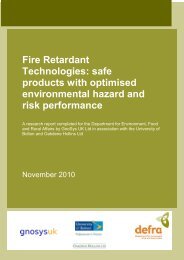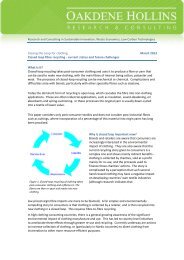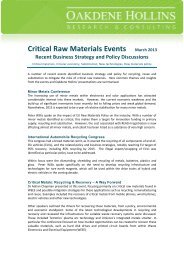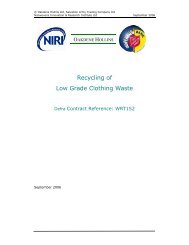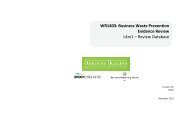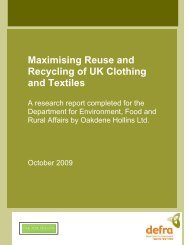Procurement and Supply Chain - Oakdene Hollins
Procurement and Supply Chain - Oakdene Hollins
Procurement and Supply Chain - Oakdene Hollins
Create successful ePaper yourself
Turn your PDF publications into a flip-book with our unique Google optimized e-Paper software.
WR1403: Business Waste Prevention Evidence Review<br />
L2m4-3: <strong>Procurement</strong> & <strong>Supply</strong> <strong>Chain</strong><br />
5 Conclusions<br />
5.1 Learning<br />
Good evidence has been found for procurement being used as a driver of external change (i.e.<br />
elsewhere in the supply chain), far less for procurement being used as a tool for internal change<br />
only. Having received significant promotion by the public sector, sustainable procurement <strong>and</strong><br />
supply chain management is being adopted by a growing number of private companies, especially<br />
larger ones such as multiple retailers, automotive manufacturers <strong>and</strong> large construction contractors<br />
(especially when the client is a public body – for example in the construction of schools or hospitals).<br />
However, waste prevention in the supply chain is rarely an explicit objective.<br />
In terms of approaches, a good spread of evidence was encountered for waste minimisation, clean<br />
operations <strong>and</strong> green products being driven by procurement. Most examples came from the<br />
construction, retail <strong>and</strong> food <strong>and</strong> drink sectors <strong>and</strong> usually concerned the prevention of packaging<br />
waste; reusable or returnable transit packaging, light-weighting of primary packaging <strong>and</strong> bulk<br />
packaging was commonly seen. Rather less evidence was available on product/service innovation<br />
approaches; the procurement of remanufactured products <strong>and</strong> leasing being the only examples,<br />
although the evidence on leasing is weak within the scope of the search.<br />
While public procurement has clear environmental objectives (driven by EU targets), this is not<br />
necessarily true for the private sector. Instead, motivations are more likely to be the opportunity to<br />
reduce cost <strong>and</strong> improve company performance. The importance of legislation is less clear-cut.<br />
Assuming an organisation wishes to purchase sustainably, a lack of purchaser power is the main<br />
barrier, particularly where supply chains are complex or cross international borders. In some cases,<br />
suppliers can wilfully resist the efforts of a procurer to change their (the supplier’s) behaviour.<br />
5.2 Insights<br />
As noted above, waste prevention is rarely an explicit objective of sustainable procurement. However,<br />
the concept’s definition is not a stable one: outcomes which this work would define as waste prevention,<br />
may well have been intended but have been understood by businesses as ‘waste reduction’ in a more<br />
general sense.<br />
Very little evidence was found of the impact of procurement strategies being used to drive hazardous<br />
waste reduction, although we note that hazard reduction is a key feature of the EU Ecolabel, which can<br />
be built into purchasing frameworks. It is possible that regulations such as REACH are sufficient drivers,<br />
<strong>and</strong> companies do not feel obliged to go beyond compliance with the law, although it is the belief of<br />
some, such as Action Sustainability, that businesses are increasingly influenced by CSR motives <strong>and</strong> are<br />
tackling waste prevention as an embedded component of ‘low impact’ production using supply chain<br />
initiatives. There are good examples in construction.<br />
The cost of a product or service, its functionality <strong>and</strong> perceived quality are key aspects of any<br />
procurement decision (66). Potential environmental gains - including waste prevention - although<br />
important, are apparently secondary considerations from the purchaser’s point of view. An opportunity<br />
exists for purchasers to be better apprised of the financial benefits of buying remanufactured <strong>and</strong><br />
recycled goods, as well as reusing existing stocks. Fiscal instruments already favour sustainable<br />
purchasing decisions in the UK, but scope exists for further refinements. For example, the Enhanced<br />
Capital Allowance scheme encourages users to buy the most energy-efficient electrical products, but this<br />
applies only to new purchases; remanufactured products of an equal efficiency are at present ineligible<br />
(66).<br />
36 For Defra



